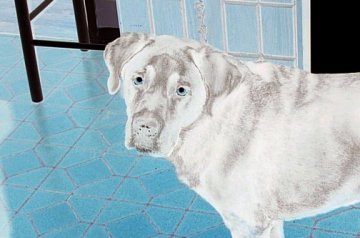
Supermodels
of New Jersey
The Dead Boy
BY K.
ELLS MENARD
The State Museum taught the dead
boy that duckbilled dinosaurs roamed the marshy coastland of New Jersey,
and thus prehistoric fossils lay beneath all the soccer fields, undeveloped
woods, right in the dead boy’s backyard, maybe beneath his driveways’ asphalt.
The dead boy I knew also learned that the State Museum could draw lines
from star to star to form constellations. That there’s no limit to the
forms in the sky. At night, trying to will a dinosaur, the dead boy made
connections, always half-frustrated / half-exhilarated that no clear white
lines connected the stars when he looked into space. Reclining beneath
projections on the domed ceiling of the State Museum’s planetarium, everything
clear with scorpions, big and little dippers, bears, and lions above him,
all clearly defined with white lines.
At first, the dead boy felt the State
Museum deceived him. No lines between the stars. The State Museum taught
him about heavenly scorpions, big and little dippers, bears, and lions,
and where were they now? Where were the official constellations? Where
were they? Maybe you had to pay the State Museum to see lines drawn between
the stars. If the State Museum wanted to mislead, the dead boy decided
he would create his own connections rather than struggle to restrict himself
to the State Museum’s celestial stick-figures. If the State Museum told
him dinosaurs were beneath him, the dead boy would find them above. He
would will a dinosaur to appear, following one star to another—that one:
a tail-star; that one: a knee-star—and so on, until, by the time he connected
all these imaginary lines from a tail-star to a duckbill star, the point
he chose to begin drawing the constellation vanished, and all stars became
all other stars, closer, brighter, dimmer, farther away. Constellations
clouded over, unseen night after night, disappearing above clouds. And
when these connections were no longer accessible, the dead boy remembered
that dinosaurs were beneath his feet. Or so instructed the State Museum.
The dead boy started digging in the
backyard. Digging and digging. He figured that the potential of finding
a dinosaur perfectly preserved obliged him to dig in his backyard. His
parents consented, inconceivably, possibly thinking that after trying to
cut through the first impeding root, he’d give up on all the drama of unearthing
a fossil. Showing respect for his whims and interests, however, the dead
boy’s parents let him tear into the backyard. He dug holes all over the
backyard, spending hours, forgetting about street football, television,
fishing sunfish to throw back into the local pond. A single hole, no matter
how deep, could miss a lode of bones just a foot from where he cut. The
dead boy found rocks that could be arrowheads. Chunks of triangular stones
with hairy roots hanging off them. No fossils. Not even a deer carcass
that melted back into the earth. Nothing. Mounds of dirt everywhere, all
that labor, an impossible amount of work for a kid, transforming the backyard
into an artillery casualty. Some holes went no further than a foot. Like
short punctures for a flag pole. Other holes went as far down as the dead
boy could dig them.
One hole he spent two weeks on. Digging
hour after hour. The dead boy could stand in it and not even come close
to seeing what was around him when he was all the way down. He had to dig
steps in the hole’s walls to climb out. For awhile the dead boy thought
about closing all the other holes and concentrating only on one, figuring
that short diggings only sampled what was just below the surface of the
yard. Then he closed them all, packed the dirt back down, because the dead
boy knew that if he worked on one and kept with it, he’d eventually find
something. He had heard about magma. Down and down and down.
The dead boy eventually needed to
lean a ladder against the hole’s wall to reach the first few steps he dug
when the hole became too deep to pull himself out. For awhile the dead
boy tried to dig tunnels, a circuit of burrows beneath the backyard. If
he began digging out from a place already several feet beneath his annihilated
lawn, the chances of finding something would be better than if he just
continued digging short holes. If he found nothing at all, only dirt and
stones pushed behind him, his work wouldn’t be wasted. He’d have carved
an underworld, a subterranean system, a place he could explore or expand,
always on the verge of discovering something, always developing, continuing.
The dead boy wouldn’t dig at night,
however. He’d sit at the bottom of the hole and stare up through the portal
he cut. He’d see a star or two. Sometimes a cluster of stars would pass
overhead and the dead boy would flip them around through various forms,
whatever they reminded him of, nothing now symbolic or purposefully charged.
He would sometimes say something aloud, and then see if he could draw the
lines, make the connections between his words and the stars that appeared
in the circle of sky above him. But where did that get him? In a little
developing labyrinth, a crypt empty of anything precious, in passages he
dug searching for an ancient relative of the mallard. The dead boy looked
up at the few stars the sky positioned above him, drawing lines that would
disappear as soon as he willed them, his words streaming through a now-buried
system of earth. The dead boy I knew used to do this sort of thing a lot,
as if that weren’t reason enough.
On Liberating
Flies
The Ruins
